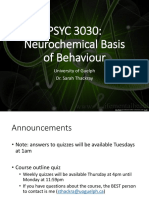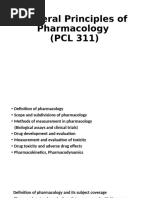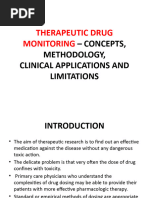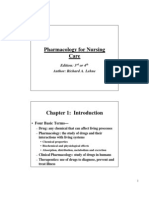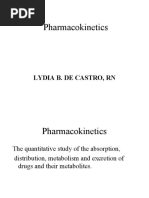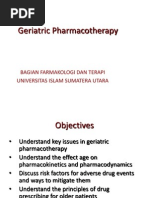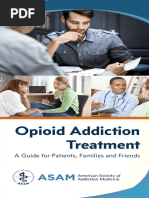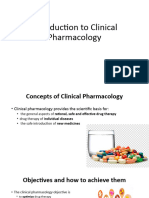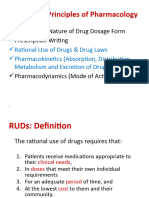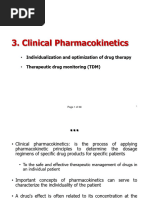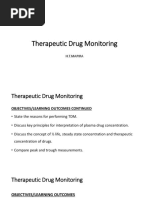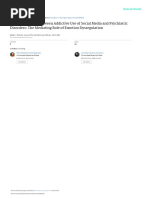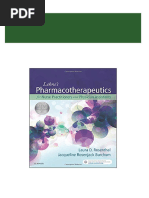0 ratings0% found this document useful (0 votes)
68 viewsPsychiatry III: General Principles of Psychopharmacology
Psychiatry III: General Principles of Psychopharmacology
Uploaded by
NoyThis document provides an overview of psychopharmacology and the general principles of treating psychotic disorders with medication. It discusses how advances in understanding brain function have led to more effective and targeted drugs. It describes factors in drug selection, mechanisms of action, side effects, dosing, and treatment outcomes. Combining psychotherapy and pharmacotherapy is emphasized as the most effective approach. Special populations like children, elderly, and pregnant women require extra consideration.
Copyright:
© All Rights Reserved
Available Formats
Download as PDF, TXT or read online from Scribd
Psychiatry III: General Principles of Psychopharmacology
Psychiatry III: General Principles of Psychopharmacology
Uploaded by
Noy0 ratings0% found this document useful (0 votes)
68 views72 pagesThis document provides an overview of psychopharmacology and the general principles of treating psychotic disorders with medication. It discusses how advances in understanding brain function have led to more effective and targeted drugs. It describes factors in drug selection, mechanisms of action, side effects, dosing, and treatment outcomes. Combining psychotherapy and pharmacotherapy is emphasized as the most effective approach. Special populations like children, elderly, and pregnant women require extra consideration.
Original Description:
Good and Side Effects
Original Title
Medicine
Copyright
© © All Rights Reserved
Available Formats
PDF, TXT or read online from Scribd
Share this document
Did you find this document useful?
Is this content inappropriate?
This document provides an overview of psychopharmacology and the general principles of treating psychotic disorders with medication. It discusses how advances in understanding brain function have led to more effective and targeted drugs. It describes factors in drug selection, mechanisms of action, side effects, dosing, and treatment outcomes. Combining psychotherapy and pharmacotherapy is emphasized as the most effective approach. Special populations like children, elderly, and pregnant women require extra consideration.
Copyright:
© All Rights Reserved
Available Formats
Download as PDF, TXT or read online from Scribd
Download as pdf or txt
0 ratings0% found this document useful (0 votes)
68 views72 pagesPsychiatry III: General Principles of Psychopharmacology
Psychiatry III: General Principles of Psychopharmacology
Uploaded by
NoyThis document provides an overview of psychopharmacology and the general principles of treating psychotic disorders with medication. It discusses how advances in understanding brain function have led to more effective and targeted drugs. It describes factors in drug selection, mechanisms of action, side effects, dosing, and treatment outcomes. Combining psychotherapy and pharmacotherapy is emphasized as the most effective approach. Special populations like children, elderly, and pregnant women require extra consideration.
Copyright:
© All Rights Reserved
Available Formats
Download as PDF, TXT or read online from Scribd
Download as pdf or txt
You are on page 1of 72
Psychiatry
III: General Principles
of Psychopharmacology
Rowalt Alibudbud, MD, DSBPP
School of Medicine
Emilio Aguinaldo College
Psychopharmacology
• Psychopharmacologic advances continue dramatically to expand the
parameters of psychiatric treatments.
• Greater understanding of how the brain functions has led to more
effective, less toxic, better-tolerated, and more specifically targeted
therapeutic agents.
• Newer drugs may lead ultimately to side effects that are not recognized
initially.
• Keeping up with the latest research findings is increasingly important as
these findings proliferate.
• A thorough understanding of the management of medication-induced side
effects is necessary.
Drug Selection
• Psychotropics are similar in overall effectiveness for their indicated disorder
• Differ considerably in their pharmacology and in their efficacy and adverse
effects on individual patients.
• The ability of a drug to prove effective is only partially predictable and is
dependent on poorly understood patient variables
• No drug is universally effective, and no evidence indicates the unambiguous
superiority of any single agent as a treatment for any major psychiatric
disorders.
• The only exception, clozapine, is a treatment for cases of treatment-
refractory schizophrenia.
Pharmacodynamics
Receptors
• Drug actions are mediated through the effects of drug ligand
molecules on drug receptors in the body.
• Most receptors are large regulatory molecules that influence
important:
• Biochemical processes (eg, enzymes involved in glucose
metabolism) or
• Physiologic processes (eg, ion channel receptors, neurotransmitter
reuptake transporters, and ion transporters).
Receptors
• Agonist - drug-receptor binding results in activation of the receptor
• Antagonist – if inhibition results
• Reverse Agonist – if opposite effect results
• Dose-response curves – Quantitation of the effects of drug-receptor
binding as a function of dose
Therapeutic Index
• Ratio of the dose that produces toxicity to the dose
that produces a clinically desired or effective response
in a population of individuals
• Doses that produce the therapeutic effect and the
toxic effect in fifty percent of the population are
employed (ED50 and TD50 )
Mode of Action
• The mechanisms through which most psychotropic drugs produce
their therapeutic effects remain poorly understood.
• Standard explanations focus on ways that drugs alter synaptic
concentrations of dopamine, serotonin, norepinephrine, histamine,
gamma-aminobutyric acid (GABA), or acetylcholine.
Side effects
• Side effects are an unavoidable risk of medication treatment.
• Side effect considerations include the probability of its occurrence, its
impact on a patient's quality of life, its time course, and its cause.
• No side effect, no matter how common, occurs in every patient.
• Side effects can result from the same pharmacological action that is
responsible for a drug's therapeutic activity or from an unrelated
property.
Side Effects
• Somnolence • Sweating
• Gastrointestinal Disturbance • Cardiovascular disturbance such
• Movement disorders as increased QTc interval
• Sexual dysfunction • Rash
• Weight gain/loss • Idiosyncratic reactions such as
sleepwalking, binge-eating and
• Glucose changes aggressive outbursts
• Hyponatremia
• Cognitive impairment
Overdose
• Almost all of the newer agents, however, have a wide margin of safety
when taken in overdose.
• By contrast, older agents such as TCAs could be fatal.
• In cases in which suicide is a major concern, an attempt should be
made to verify that the medication is not being hoarded:
• Random pill counts
• asking a family member to dispense daily doses may be helpful
• Large quantities of medications with a low therapeutic index should be
prescribed judiciously.
Pharmacokinetics
Absorption
• Bioavailability - amount absorbed into the systemic circulation divided
by the amount of drug administered
• Determinants:
• Route
• Blood flow (IM and SQ)
• Permeability
Common
Routes
Common
Routes
Distribution of the Drug
•Determinants:
• Blood flow
• Organ size
• Solubility
• Binding of the drug
• Capillary permeability
Metabolism
• The action of many drugs (eg, sympathomimetics,
phenothiazines) is terminated before they are excreted
because they are metabolized to biologically inactive
derivatives.
• In contrast, prodrugs (eg, levodopa, minoxidil) are inactive as
administered and must be metabolized in the body to
become active.
• Many drugs are active as administered and have active
metabolites as well (eg, morphine, some benzodiazepines).
• Some drugs (eg, lithium, many others) are not modified by
the body; they continue to act until they are excreted.
Elimination
• Removal of a drug from the body occurs via a number of
routes, the most important being through the kidney into
the urine.
• Other routes include the bile, intestine, lung, or milk in
nursing mothers.
Patient related factors
• Response to medication and sensitivity to side effects are influenced
by factors related to the patient:
• Diagnosis
• Past treatment response
• Response in family members
• Concurrent psychiatric or medical disorders
Dosing
• Clinically effective dose for treatment depends on the characteristics
of the drug and patient factors, such as:
• inherited sensitivity
• Ability to metabolize a drug
• Concurrent medical disorders
• Use of concurrent medications
• History of exposure to previous medications
• Drug potency
Duration of treatment
• Factors that affect the duration of treatment:
1. nature of the disorder
2. the duration of symptoms
3. the family history
4. the extent to which the patient tolerates and benefits from the medication
• Treatment is usually divided into 3 phases:
1. the initial therapeutic trial
2. the continuation phase
3. the maintenance phase
Frequency of Follow-up
• Determined by clinical judgment.
• In severely ill patients, this might mean several times a week.
• Patients on maintenance therapy, even when stable, need
monitoring, but no consensus exists on the frequency of follow-up
therapy.
• Three months is a reasonable interval between visits, but 6 months
may be adequate after long-standing treatment.
Laboratory testing
• Laboratory testing and therapeutic blood monitoring should be based
on clinical circumstances and the drugs being used.
• For most commonly used psychotropic drugs, routine testing is not
required.
• No currently available laboratory test can confirm the diagnosis of a
mental disorder.
• Pretreatment tests are routine as part of a workup to establish
baseline values and to rule out underlying medical problems
Laboratory testing
• Common Laboratory testing requested:
• CBC
• Electrolytes
• Renal function tests
• Hepatic function tests
• Lipid profile
• Blood glucose
• Cranial imaging
• EEG
• ECG
Treatment outcome
• The goal of psychotropic treatment is to eliminate all manifestations
of disorder
• Enable the patient to regain the ability to function as well and to
enjoy life as fully as before he or she became ill.
• This degree of improvement to below the syndromal threshold is
defined as remission.
Treatment Failure
• Was the original diagnosis correct?
• Are the observed symptoms related to the original disorder, or are
they actually adverse effects of the drug treatment?
• Was the drug administered at an appropriate dosage for a sufficient
length of time?
• Did a pharmacokinetic or pharmacodynamic interaction with another
drug that the patient was taking reduce the efficacy of the newly
prescribed drug?
• Did the patient take the drug as directed?
Monotherapy vs Polypharmacy
• Use of multiple agents should be avoided if possible in the treatment
of psychiatric disorders. (APA guidelines)
• Although monotherapy represents the ideal, polypharmacy, the
simultaneous use of psychotropic medications, has been
commonplace
Combined psychotherapy and
pharmacotherapy
• Studies have demonstrated that the results of combined therapy are
superior to those of either type of therapy alone.
• When pharmacotherapy and psychotherapy are used together, the
approach should be coordinated, integrated, and synergistic.
Special populations
• Children – low volume of distribution, high metabolism
• Elderly – more sensitive to side effect, lower drug metabolism and
excretion
• Pregnant women – WOF for teratogenic drugs
• Nursing women – WOF for drugs that cross that are secreted in breast
milk
• Medically ill – WOF drugs that may complicate medical illness
• Substance abuse – WOF drug interactions
Psychiatry III: Pharmacologic
interventions for Psychotic
Disorders
Rowalt Alibudbud, MD, DSBPP
School of Medicine
Emilio Aguinaldo College
Introduction
• Chlorpromazine (Thorazine) in 1952 may be the most important
single contribution to the treatment of a psychiatric illness.
• Chlorpromazine was shown to be effective at reducing hallucinations
and delusions, as well as excitement.
• It was also noted that it caused side effects that appeared similar to
Parkinsonism.
• Antipsychotics diminish psychotic symptom expression and reduce
relapse rates.
• Approximately 70 percent of patients treated with any antipsychotic
achieve remission.
Introduction
• The drugs used to treat schizophrenia have a wide variety of
pharmacological properties, but all share the capacity to antagonize
postsynaptic dopamine receptors in the brain.
• Antipsychotics can be categorized into two main groups:
• First-generation antipsychotics or dopamine receptor antagonists
• Second-generation antipsychotics or serotonin dopamine antagonists (SDAs).
• Clozapine (Clozaril), the first effective antipsychotic with negligible
extrapyramidal side effects, was discovered in 1958
• In 1976, it was noted that clozapine was associated with a substantial
risk of agranulocytosis.
Phases of treatment
• Acute phase
• Stabilization phase
• Maintenance phase
Acute Phase
• GOAL: alleviate the most severe psychotic symptoms.
• Acute psychotic symptoms require immediate attention.
• Lasts from 4 to 8 weeks.
• Patients with akathisia can appear agitated when they experience a
subjective feeling of motor restlessness.
• If patients are receiving an agent associated with extrapyramidal side
effects, usually a first-generation antipsychotic, a trial with an
anticholinergic anti-Parkinson medication, benzodiazepine, or
propranolol (Inderal) may be helpful in making the discrimination.
Acute Phase
• Options: Antipsychotics and benzodiazepines
• With highly agitated patients, intramuscular administration produces
a more rapid effect.
• An advantage of an antipsychotic is that a single intramuscular
injection of haloperidol (Haldol), fluphenazine (Prolixin, Permitil),
olanzapine (Zyprexa), or ziprasidone (Geodon) will often result in
calming without an excess of sedation.
• WOF: sedation, postural hypotension, and extrapyramidal side effects
Acute Phase
• Benzodiazepines are also effective for agitation during acute
psychosis.
• Lorazepam (Ativan) has the advantage of reliable absorption when it
is administered either orally or intramuscularly.
• Benzodiazepines may also reduce the amount of antipsychotic that is
needed to control psychotic patients.
• Some studies suggest that a longer time between the first onset of
psychosis and the initiation of treatment is related to a worse
outcome.
Stabilization and Maintenance Phases
• In the stable or maintenance phase, the illness is in remission.
• GOALS: prevent psychotic relapse and to assist patients in improving their
level of functioning.
• Stable patients who are maintained on an antipsychotic have a much lower
relapse rate than patients who have their medications discontinued.
• 16 to 23 percent of patients receiving treatment will experience a relapse within a
year
• 53 to 72 percent will relapse without medications.
• The duration of maintenance treatment after the first episode suggest that
1 or 2 years might not be adequate.
• Multiepisode patients receive maintenance treatment for at least 5 years,
and many experts recommend pharmacotherapy on an indefinite basis.
Pharmacotherapy Concerns
• Non compliance
• Poor responders
• Side effects
• Extrapyramidal symptoms
• Tardive dyskinesia
• Others
• Health monitoring while on Antipsychotics
Non Compliance
• Noncompliance with long-term antipsychotic treatment is very high.
(40 to 50 percent of patients become noncompliant within 1 or 2
years)
• Compliance increases when long-acting medication is used. Examples:
haloperidol, fluphenazine, aripiprazole, paliperidone, risperidone,
fluphenthixol
• Advantages of Long Acting Antipsychotics:
• Clinicians know immediately when noncompliance occurs and have some
time to initiate appropriate interventions before the medication effect
dissipates
• Less day-to-day variability in blood levels, making it easier to establish a
minimum effective dose
• Patients prefer it to having to remember dosage schedules of daily oral
preparations
Poor responders
• Before considering a patient a poor responder to a particular drug, it
is important to assure that they received an adequate trial of the
medication.
• 4 - to 6-week trial on an adequate dose of an antipsychotic represents
a reasonable trial for most patients.
• Patients who demonstrate mild improvement may continue to
improve at a steady rate for 3 to 6 months.
• Helpful to confirm that the patient is receiving an adequate amount
of the drug by monitoring the plasma concentration.
Poor responders
• If proven to be a poor responder:
• Shift to another antipsychotic class (from 1st gen to 2nd gen)
• Use adjunct
• Clozapine (after 2 failed drug trials of different class)
Extra pyramidal side effects
• Tremors, Rigidity, Akinesia/Akathisia, Postural Instability
• Treatment options:
• Anticholinergic anti-parkinsonian drugs
• Propranolol (akathisia)
Tardive dyskinesia
• About 20 to 30 percent of patients on long-term treatment with a
conventional DRA will exhibit symptoms of tardive dyskinesia.
• Three to five percent of young patients receiving a DRA develop
tardive dyskinesia each year.
• The risk in elderly patients is much higher.
Tardive dyskinesia
• Recommendations:
1. Using the lowest effective dose of antipsychotic
2. Prescribing cautiously with children, elderly patients, and patients with
mood disorders
3. Examining patients on a regular basis for evidence of tardive dyskinesia
4. Considering alternatives to the antipsychotic being used and considering
dosage reduction when tardive dyskinesia is diagnosed
5. Considering a number of options if the tardive dyskinesia worsens, including
discontinuing the antipsychotic or switching to a different drug
• Clozapine has been shown to be effective in reducing severe tardive
dyskinesia or tardive dystonia.
Other Side Effects
• Sedation and postural hypotension can be important side effects for
patients who are being treated with low-potency DRAs, such as
perphenazine. (initial doses)
• Most patients develop tolerance to sedation and postural hypotension,
sedation may continue to be a problem.
• All DRAs, as well as SDAs, elevate prolactin levels, which can result in
galactorrhea and irregular menses.
• Long-term elevations in prolactin and the resultant suppression in
gonadotropin-releasing hormone can cause suppression in gonadal
hormones. (leads to abnormal libido and sexual functioning; and
osteoporosis)
Health Monitoring
• Because of the effects of the SDAs on insulin and metabolism,
psychiatrists should monitor a number of health indicators, including:
• BMI
• Fasting blood glucose
• Lipid profiles
• Patients should be weighed and their BMI calculated for every visit for
6 months after a medication chane.
The risk of clozapine
• Seizure risk reaches nearly 5 percent at doses of more than 600 mg.
• Patients who develop seizures with clozapine can usually be managed by
reducing the dose and adding an anticonvulsant, usually valproate
(Depakene).
• Myocarditis has been reported to occur in approximately 5 patients
per 100,000 patient-years.
• Other side effects with clozapine include hypersalivation, sedation,
tachycardia, weight gain, diabetes, fever, and postural hypotension.
Psychiatry III: Pharmacologic
interventions for Depressive
Disorders
Rowalt Alibudbud, MD, DSBPP
School of Medicine
Emilio Aguinaldo College
Introduction
• GOALS:
1. The patient's safety must be guaranteed
2. Complete diagnostic evaluation
3. Address not only the immediate symptoms but also the patient's
prospective well-being should be initiated.
4. Address the number and severity of stressors in patients' lives.
• Because the prognosis for each episode is good, optimism is always
warranted
• Mood disorders are chronic, however, and the psychiatrist must
educate the patient and the family about future treatment strategies.
Introduction
• The use of specific pharmacotherapy approximately doubles the
chances that a depressed patient will recover in 1 month.
• All currently available antidepressants may take up to 3 to 4 weeks to
exert significant therapeutic effects, although they may begin to show
their effects earlier.
• Choice of antidepressants is determined by:
1. Side effect profile least objectionable to a given patient's physical status
2. Temperament
3. Lifestyle
4. Previous response
Principles
• Dosage of an antidepressant should be raised to the maximum
recommended level and maintained at that level for at least 4 or 5
weeks before a drug trial is considered unsuccessful.
• When a patient does not begin to respond to appropriate dosages of
a drug after 2 or 3 weeks, clinicians may decide to obtain a plasma
concentration of the drug.
• Result may indicate either noncompliance or particularly unusual
pharmacokinetic disposition of the drug.
Duration
• Antidepressant treatment should be maintained for at least 6 months
or the length of a previous episode, whichever is greater.
• Prophylactic treatment with antidepressants is effective in reducing
the number and severity of recurrences.
• Episodes that have involved significant suicidal ideation or
impairment of psychosocial functioning may indicate that clinicians
should consider prophylactic treatment.
• When antidepressant treatment is stopped, the drug dose should be
tapered gradually over 1 to 2 weeks, depending on the half-life of the
particular compound.
Prophylaxis
• Prevention of new mood episodes is the aim of the maintenance
phase of treatment.
• Only those patients with recurrent or chronic depressions are
candidates for maintenance treatment.
Medication selection
• The available antidepressants do not differ in overall efficacy, speed of response,
or long-term effectiveness.
• They differ in their pharmacology, drug-drug interactions, short- and long-term
side effects, likelihood of discontinuation symptoms, and ease of dose
adjustment.
• Selection of the initial treatment depends on:
• Chronicity of the condition
• Course of illness
• Family history of illness and treatment response
• Symptom severity
• Concurrent general medical or other psychiatric conditions
• Prior treatment responses to other acute phase treatments
• Potential drug-drug interactions
• Patient preference
Treatment of Depressive Subtypes
• Major depressive disorder with atypical features (sometimes called
hysteriod dysphoria) – MAOIs or SSRIs or Bupropion
• Melancholic depressions – SNRI
• Seasonal winter depression – light therapy
• Major depressive episodes with psychotic features – combination of
an antidepressant and an atypical antipsychotic.
• Several studies have also shown that ECT is more effective than
pharmacotherapy.
Comorbid Disorders
• The non-mood disorder dictates the choice of treatment in comorbid
states.
• Concurrent substance abuse raises the possibility of a substance-
induced mood disorder, which must be evaluated by history or by
requiring abstinence for several weeks.
• The successful treatment of OCD associated with depressive
symptoms usually results in remission of the depression.
• When panic disorder occurs with major depression, medications with
demonstrated efficacy in both conditions are preferred
• Presence of a major depressive episode is associated with increased
morbidity or mortality of many general medical conditions
Therapeutic use of side effects
• Using Sedating antidepressants for more anxious, depressed patients
or Using Activating agents for more psychomotor-retarded patients is
not generally helpful.
• These drugs often continue their side effects in the longer run, which
can lead to patients prematurely discontinuing medication
• Use adjunctive medications combined with antidepressants to
provide more immediate symptom relief. .
Treatment failures
• Patients may not respond to a medication, because:
• they cannot tolerate the side effects
• An idiosyncratic adverse event may occur
• Clinical response is not adequate
• Wrong diagnosis has been made
• Acute phase medication trials should last 4 to 6 weeks to determine if
meaningful symptom reduction is attained.
• Approximately one half of patients require a second medication
treatment trial because the initial treatment is poorly tolerated or
ineffective.
Second line agents
• The choice between switching depends on:
1. Patient's prior treatment history
2. Degree of benefit achieved with the initial treatment
3. Patient preference
• As a rule, switching rather than augmenting is preferred after an initial
medication failure.
• Augmentation strategies are helpful with patients who have gained some
benefit from the initial treatment but who have not achieved remission
• Augmentation strategies:
1. Lithium (Eskalith)
2. Thyroid hormone
3. Bupropion (Wellbutrin)
Combined treatment
• Medication and formal psychotherapy are often combined in practice.
• Combination of pharmacotherapy and psychotherapy for chronically
depressed outpatients have shown a higher response and higher
remission rates for the combination than for either treatment used
alone.
Psychiatry III: Pharmacologic
interventions for Bipolar-related
Disorders
Rowalt Alibudbud, MD, DSBPP
School of Medicine
Emilio Aguinaldo College
Introduction
• The pharmacological treatment of bipolar disorders is divided into:
1. Acute (mania or depression) phase
2. Maintenance phase
• Mood stabilizers are associated with unique side effect sand safety
profiles
• No one drug is predictably effective for all patients.
Acute mania
• The treatment of acute mania, or hypomania, usually is the easiest
phases of bipolar disorders to treat
• Patients with severe mania are best treated in the hospital where
aggressive dosing is possible and an adequate response can be
achieved within days or weeks.
• Adherence to treatment, however, is often a problem
• Patients with mania frequently lack insight, and refuse to take
medication.
Lithium
• Prototypical mood stabilizer
• Onset of antimanic action with lithium can be slow
• Usually supplemented in the early phases of treatment by atypical
antipsychotics, mood-stabilizing anticonvulsants, or high-potency
benzodiazepines.
• Therapeutic lithium levels are between 0.6 and 1.2 mEq/L
• Limitations:
• Unpredictable efficacy
• Problematic side effects
• Need for frequent laboratory tests
Valproate
• Surpassed lithium in use for acute mania
• Only indicated for acute mania although most experts agree it also
has prophylactic effects
• Typical dose are 750 to 2,500 mg per day
• Therapeutic blood levels between 50 and 120 µg/mL
• Rapid oral loading with 15 to 20 mg/kg of divalproex sodium from day
1 of treatment has been well tolerated and associated with a rapid
onset of response.
• Laboratory tests are required during valproate treatment
Carbamazepine and oxcarbazepine
• First-line treatment for acute mania
• Typical doses to treat acute mania range between 600 and 1,800 mg
• Therapeutic blood level is between 4 and 12 µg/mL.
• The keto congener of carbamazepine, oxcarbazepine, may possess
similar antimanic properties.
• Higher doses than those of carbamazepine are required, because 1,500 mg of
oxcarbazepine approximates 1,000 mg of carbamazepine.
Benzodiazepines
• The high-potency benzodiazepine is used in acute mania include
(clonazepam and lorazepam)
• Effective and widely used for adjunctive treatment of acute manic
agitation, insomnia, aggression, and dysphoria, and panic
• Safety and the benign side effect profile of these agents render them
ideal adjuncts to lithium, carbamazepine, or valproate.
Antipsychotics
• All of the atypical antipsychotics olanzapine, risperidone, quetiapine,
ziprasidone, and aripiprazole have demonstrated antimanic efficacy
and are FDA approved for this indication.
• ADVANTAGES: lesser liability for excitatory postsynaptic potential and
tardive dyskinesia; many do not increase prolactin.
• LIMITATIONS: insulin resistance, diabetes, hyperlipidemia,
hypercholesteremia, and cardiovascular impairment
Bipolar Depression
• Antidepressants - propensity to induce cycling, mania, or hypomania.
But, it is enhanced by a mood stabilizer in the first-line treatment for
a first or isolated episode of bipolar depression.
• Combination of olanzapine and fluoxetine (Symbyax) – effective in
treating acute bipolar depression without inducing a switch to mania
or hypomania.
• Lamotrigine, Quetiapine or low dose ziprasidone – are also effective
• Electroconvulsive therapy – for patients with intense suicidal
tendency
Other agents
• When standard treatments fail, other types of compounds may prove
effective. Such as:
• Calcium channel antagonist verapamil (Calan, Isoptin)
• Gabapentin, topiramate, zonisamide, levetiracetam, and tiagabine
Maintenance phase
• GOAL: sustained euthymia
• Preventing recurrences of mood episodes is the greatest challenge
facing the clinician.
• Sedation, cognitive impairment, tremor, weight gain, and rash are
some side effects that lead to treatment discontinuation.
• Lithium, carbamazepine, and valproic acid, alone or in combination,
are the most widely used agents in the long-term treatment
• Lamotrigine has prophylactic antidepressant and, potentially, mood-
stabilizing properties.
Maintenance phase
• Thyroid supplementation is frequently necessary during long-term
treatment.
• Many patients treated with lithium develop hypothyroidism
• Many patients with bipolar disorder have idiopathic thyroid dysfunction.
• T3 (25 to 50 µg per day), because of its short half-life, is often recommended
for acute augmentation strategies
• T4 is frequently used for long-term maintenance. In some centers,
hypermetabolic doses of thyroid hormone are used.
You might also like
- Geriatric Nursing Review QuestionsDocument30 pagesGeriatric Nursing Review QuestionsPortia Dulce Toquero88% (101)
- Prescribing Psychotropics: From Drug Interactions to PharmacogeneticsFrom EverandPrescribing Psychotropics: From Drug Interactions to PharmacogeneticsRating: 5 out of 5 stars5/5 (2)
- Pharmacology Lecture NotesDocument162 pagesPharmacology Lecture NotesKwabena Amankwa100% (2)
- Wygant (2014) Paternal Deprivation Harmful Effects Child Development - 4aaaDocument11 pagesWygant (2014) Paternal Deprivation Harmful Effects Child Development - 4aaaShawn A. WygantNo ratings yet
- Report VLCCDocument11 pagesReport VLCCShounak Dutta100% (1)
- Treatment of Schizophrenia and Management of Drug SideDocument83 pagesTreatment of Schizophrenia and Management of Drug SideAbelNo ratings yet
- 2-PSYC 3030 - Principles of PharmacologyDocument47 pages2-PSYC 3030 - Principles of PharmacologySarah McCabeNo ratings yet
- Principles of Drug Abuse Spring 2021Document33 pagesPrinciples of Drug Abuse Spring 2021Fatma HishamNo ratings yet
- St. Jean - Advanced Pharmacology for nursingDocument28 pagesSt. Jean - Advanced Pharmacology for nursingamitsingh933703No ratings yet
- Drugs in The ElderlyDocument38 pagesDrugs in The ElderlyMyda Efron ArchuletaNo ratings yet
- Lecture 2 Principles of Drugs 0Document36 pagesLecture 2 Principles of Drugs 0Musa yohanaNo ratings yet
- Medication HolidaysDocument25 pagesMedication HolidaysAdeyemi SegunNo ratings yet
- Paramedic Inter Facility Transfer TrainingDocument38 pagesParamedic Inter Facility Transfer Training2131443100% (1)
- Paramedic Inter Facility Transfer Training: Pharmacology ReviewDocument38 pagesParamedic Inter Facility Transfer Training: Pharmacology ReviewfilchibuffNo ratings yet
- Therapeutic Drug Monitoring Y4Document12 pagesTherapeutic Drug Monitoring Y4Promise NcubeNo ratings yet
- PCL 311 General Principles of Pharmacology 2021 2022Document56 pagesPCL 311 General Principles of Pharmacology 2021 2022happyjimoh444No ratings yet
- PCL 311 General Principles of Pharmacology 2024 2025Document56 pagesPCL 311 General Principles of Pharmacology 2024 2025aminateminentNo ratings yet
- Therapeutic Drug MonitoringDocument30 pagesTherapeutic Drug MonitoringusamaugandaNo ratings yet
- DSM VDocument43 pagesDSM VAndrassyGNo ratings yet
- Pharmacology For Nursing. Richard A. LehneDocument62 pagesPharmacology For Nursing. Richard A. LehneJC Ortiz-Carrillo50% (2)
- Toxicology and PahrmacovigillanceDocument27 pagesToxicology and Pahrmacovigillancebelloaliyuimam01No ratings yet
- FACTORS MODIFYING DRUGSDocument26 pagesFACTORS MODIFYING DRUGSgladyskalpananaNo ratings yet
- Pharmacokinetics: Lydia B. de Castro, RNDocument37 pagesPharmacokinetics: Lydia B. de Castro, RNNick AlfaroNo ratings yet
- Intro To Pharma For PDF 2024 2025Document39 pagesIntro To Pharma For PDF 2024 2025Maita Anne Shey BalagNo ratings yet
- Amien GPP 6 MedDocument25 pagesAmien GPP 6 MedAmanuel MaruNo ratings yet
- Adverse Drug Reaction - FinaleDocument67 pagesAdverse Drug Reaction - FinaleMiguel Ligas0% (1)
- Theraputic Drug MonitoringDocument24 pagesTheraputic Drug Monitoringkaranchumber12986No ratings yet
- Drug Use DisordersDocument22 pagesDrug Use DisordersBright KumwendaNo ratings yet
- Geriatric PharmacotherapyDocument28 pagesGeriatric PharmacotherapyRaja Alfian IrawanNo ratings yet
- 3a Introduction To Drug TherapyDocument69 pages3a Introduction To Drug TherapynipoNo ratings yet
- asam-opioid-patient-pieceDocument8 pagesasam-opioid-patient-pieceyiy yuyNo ratings yet
- NSC 202 MedicationDocument61 pagesNSC 202 MedicationifasomoladesignalNo ratings yet
- Basic Pharmacology ReviewDocument39 pagesBasic Pharmacology ReviewWosen AberaNo ratings yet
- Efficacy and Safety of For Treatment of Schizophrenia: LumateperoneDocument40 pagesEfficacy and Safety of For Treatment of Schizophrenia: LumateperoneReyadh JassemNo ratings yet
- Therapeutic Drug Monitoring-FinalDocument49 pagesTherapeutic Drug Monitoring-FinalSaiesh PhaldesaiNo ratings yet
- Outline Drug Therapy in Older AdultsDocument4 pagesOutline Drug Therapy in Older Adultsswillis1No ratings yet
- Chapter 4 Pharmacotherapeutics, Dynamics & KineticsDocument47 pagesChapter 4 Pharmacotherapeutics, Dynamics & KineticsAshaNo ratings yet
- Mod.1. Intro To CL - PharmacologyDocument42 pagesMod.1. Intro To CL - PharmacologynaimaNo ratings yet
- Opt 352 (General Pharmacology) - 1Document27 pagesOpt 352 (General Pharmacology) - 1yjq2gtd245No ratings yet
- PSYC 3030: Neurochemical Basis of Behaviour: University of Guelph Dr. Sarah ThackrayDocument15 pagesPSYC 3030: Neurochemical Basis of Behaviour: University of Guelph Dr. Sarah ThackraySarah McCabeNo ratings yet
- Psycho PharmaDocument188 pagesPsycho Pharmavinnie kimNo ratings yet
- RUDs + PharmacokineticsDocument53 pagesRUDs + PharmacokineticsdaghameendoniaNo ratings yet
- Chapter 16Document65 pagesChapter 16Harrison SohnNo ratings yet
- Causality Assessment of ADRsDocument45 pagesCausality Assessment of ADRsKrupasagar Pn PalegarNo ratings yet
- 3 Clinical PharmacokineticsDocument68 pages3 Clinical PharmacokineticsnahomNo ratings yet
- Therapeutic Drug Monitoring: H.T.MapiraDocument36 pagesTherapeutic Drug Monitoring: H.T.MapirakagameNo ratings yet
- Pharmacology for NursingDocument39 pagesPharmacology for Nursingtedasetesama8No ratings yet
- Treatment Resistant OcdDocument70 pagesTreatment Resistant Ocddrkadiyala2100% (1)
- Pharmacogenomics: When Drug Treatment Becomes Personalized MedicineDocument18 pagesPharmacogenomics: When Drug Treatment Becomes Personalized MedicineVidyaNo ratings yet
- WEEK 5 Biomedical Model of AddictionDocument13 pagesWEEK 5 Biomedical Model of AddictionMugwe KamaNo ratings yet
- Therapeutic Drug Monitoring 7-1-20Document27 pagesTherapeutic Drug Monitoring 7-1-20mofadhil100% (1)
- Therapeutic Drug Monitoring: Saeed Alqahtani, Pharmd, PHDDocument78 pagesTherapeutic Drug Monitoring: Saeed Alqahtani, Pharmd, PHDAnonymous hF5zAdvwCC67% (3)
- 08.16.16 - Assessment of Substance Use-In ClassDocument22 pages08.16.16 - Assessment of Substance Use-In ClassKNo ratings yet
- Pertemuan 8. TDM Atau PKODDocument43 pagesPertemuan 8. TDM Atau PKODBudi SayogaNo ratings yet
- التخدير نظري 2Document14 pagesالتخدير نظري 2asooalkaissiNo ratings yet
- Treatment-emergent Sexual Dysfunctions Due to Antidepressants. ROBINDocument35 pagesTreatment-emergent Sexual Dysfunctions Due to Antidepressants. ROBINAbhishek KalraNo ratings yet
- Therapeutic Drug Monitoring: RVS Chaitanya KoppalaDocument33 pagesTherapeutic Drug Monitoring: RVS Chaitanya KoppalaDr. Raghavendra Kumar Gunda100% (1)
- Fundamental Concepts of Pharmacology 2Document37 pagesFundamental Concepts of Pharmacology 2rp58g6cmfjNo ratings yet
- PLB 1 B 8 Rianti NovalianaDocument21 pagesPLB 1 B 8 Rianti NovalianavikaseptideyaniNo ratings yet
- Medical Encyclopedia XXL: Prof. J.P. Schadé, M.D., Ph.D. D.Sc.hcFrom EverandMedical Encyclopedia XXL: Prof. J.P. Schadé, M.D., Ph.D. D.Sc.hcNo ratings yet
- America's Affair with Opioids: 10 Steps to Reverse the Opioid CrisisFrom EverandAmerica's Affair with Opioids: 10 Steps to Reverse the Opioid CrisisNo ratings yet
- Teen Depression - Symptoms and CausesDocument2 pagesTeen Depression - Symptoms and CausesNeo RealyouNo ratings yet
- Pi Nclex Module ReviewDocument192 pagesPi Nclex Module ReviewDan kibet TumboNo ratings yet
- Download Full An Invitation to Health: Taking Charge of Your Health 19th Edition Dianne Hales PDF All ChaptersDocument51 pagesDownload Full An Invitation to Health: Taking Charge of Your Health 19th Edition Dianne Hales PDF All Chaptersnodaljillige100% (3)
- Biology of Depression: Edited by Julio Licinio and Ma-Li WongDocument38 pagesBiology of Depression: Edited by Julio Licinio and Ma-Li WongAnonymous 3Uy0HjXKNo ratings yet
- Mental Health ChecklistsDocument21 pagesMental Health ChecklistsRemymar AnisNo ratings yet
- H.O.P.E 11: Saint Louis School of Sablan IncDocument9 pagesH.O.P.E 11: Saint Louis School of Sablan IncMacgile CovadisNo ratings yet
- Med-Surg Practice Test 100Document73 pagesMed-Surg Practice Test 100Muyan Bearneza100% (1)
- UntitledDocument241 pagesUntitledapi-257817850No ratings yet
- Instant Access To The Bipolar Advantage First Edition (Presumed No Earlier Dates Stated) Tom Wootton Ebook Full ChaptersDocument70 pagesInstant Access To The Bipolar Advantage First Edition (Presumed No Earlier Dates Stated) Tom Wootton Ebook Full Chapterserkandtaisja100% (9)
- Smiling DepressionDocument6 pagesSmiling Depressionmarketing globalmegaexhibitionNo ratings yet
- Neuropsychiatric and Work Outcomes After COVID 19Document3 pagesNeuropsychiatric and Work Outcomes After COVID 19Dragutin PetrićNo ratings yet
- Cognitive Behavioral Therapy (CBT) - Application To Depression & Low Self-EsteemDocument33 pagesCognitive Behavioral Therapy (CBT) - Application To Depression & Low Self-EsteemCarlo BajaNo ratings yet
- The Great Depression - SpeechDocument2 pagesThe Great Depression - SpeechJams Florendo100% (2)
- Met 4 Powers of The MindDocument9 pagesMet 4 Powers of The MindSophia BompatNo ratings yet
- The Relationship Between Addictive Use of Social MDocument11 pagesThe Relationship Between Addictive Use of Social Mvinubharath.testerNo ratings yet
- Learning Process-Based Therapy CAP 1Document8 pagesLearning Process-Based Therapy CAP 1Leidy PinzonNo ratings yet
- Activity 8 - 5 Issues in The PhilippinesDocument3 pagesActivity 8 - 5 Issues in The PhilippinesChristel Mae BoseoNo ratings yet
- Psychological Aspects of Living With HIV Disease: PracticeDocument4 pagesPsychological Aspects of Living With HIV Disease: PracticeAntro BerrinNo ratings yet
- Neet PsychiatryDocument304 pagesNeet PsychiatryASHISHNo ratings yet
- The Impact of Social Media Use On Social IsolationDocument60 pagesThe Impact of Social Media Use On Social Isolationgwelfort12No ratings yet
- Abnormal Psychology 9th Edition Comer Test BankDocument44 pagesAbnormal Psychology 9th Edition Comer Test Bankisaacnorrisezwasfmtgi100% (38)
- Klinika Za Psihijatriju Slucajevi PrevodDocument24 pagesKlinika Za Psihijatriju Slucajevi PrevodEra69No ratings yet
- A Research Paper On DepressionDocument17 pagesA Research Paper On DepressionKurt lawrence Alejo100% (2)
- Steghaus Poth 2021 RSQDocument22 pagesSteghaus Poth 2021 RSQnishthaupadhyay71No ratings yet
- Adults Tool KitDocument30 pagesAdults Tool KitCamila Constanza Soto EspinozaNo ratings yet
- Ebooks File (Ebook PDF) Lehne's Pharmacotherapeutics For Advanced Practice Providers All ChaptersDocument39 pagesEbooks File (Ebook PDF) Lehne's Pharmacotherapeutics For Advanced Practice Providers All Chapterssanchesheay100% (4)
- Counseling and Mental HealthDocument4 pagesCounseling and Mental HealthevandaNo ratings yet







